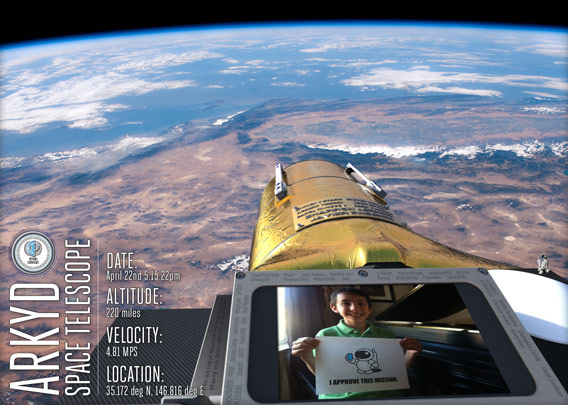Asteroid Mining Company Kickstarts a Space Telescope
SLATE
Posted
Wednesday, May 29, 2013, at 1:16 PM

Illustration of the proposed orbiting ARKYD small space telescope controlled by the public.
Illustration by PRI
Illustration by PRI
Planetary Resources, Inc.—the company that wants to mine asteroids—has a new project they've just announced: They're crowdfunding a space telescope.
Yup, you read that right. PRI has a Kickstarter page set up
to fund a small (20 cm, or 8”) telescope that will orbit the Earth. It
will take pictures of our planet from above, and astronomical objects,
too. Different funding levels will give people different access to the
telescope. In a clever twist, if you back it at the $25 or above level,
you can upload a picture of yourself that will be displayed on a small
screen, and the satellite will take a picture of your picture with the
Earth as a backdrop.

Pledging $25 or more gets a photo of a photo you uploaded to the 'scope.
Illustration by PRI
Illustration by PRI
This is one step of PRI’s overall goal to eventually mine asteroids.
The company’s plan is a series of steps leading to that ultimate goal,
including launching several small telescopes to observe the Earth and
sky, survey the sky to find near-Earth asteroids, create small probes
that can visit and study asteroids, and eventually mine them for useful
materials. I have a detailed description of their plans from when they first announced them in 2012.
This crowdfunded space telescope, called ARKYD, is a way for them to
test out their abilities to launch and use such a satellite. PRI has
already invested quite a bit of money into the development of a series
of telescopes—mostly to look for asteroids, but this new one has
different goals and therefore a different design. While they are still
putting their own money into designing and building it, the Kickstarter
is a way to get people involved personally. It has a series of
astronomical filters on it (for the nerds out there: UV (< 300 nm),
B, V, R, [OIII], Hα, 1 μm, and a clear (luminence) filter) which means
you can create near-true-color pictures, too. It’s not a huge telescope,
and you don’t get vast amounts of time, but it should be fine to get
nice shots of bright nebulae and galaxies.
My personal opinion is that this is a legit effort, and should work
pretty well. I like the idea of people using it to observe objects they
want—getting something like this in the hands of kids in classrooms will
do a huge amount positive outreach. You can donate your time to
scientists or classrooms, too.
I’ll be curious to see if some of the claims pan out; for example,
they talk about finding asteroids with ARKYD, but given the size and
filter choice it’s not optimized for it. The ‘scope should find quite a
few rocks, but discovering new ones is a tough game these days. It
generally takes big telescopes with lots of time to find previously
undiscovered asteroids; most are very faint. But it could find a few,
which is enough for PRI’s initial purposes.
The other claims look solid enough. Given the small size and low
mass, launching ARKYD isn’t all that expensive, and the running costs
can be covered if they get enough money pledged. A million dollars is
doable via Kickstarter; as I write this they already have more than
$40,000 pledged before the official announcement was even made public
(the Kickstarter page went live a bit early to test it out). I know my
geeks, and I suspect PRI will meet their goal pretty quickly.
Bottom line: I think this is a good idea, it can work, and if it does
it’ll be a great way to get the public excited about space exploration
and discovery. The team is solid (I saw a few old friends in the video,
and the engineering team is made of lots of ex-NASA folks who have
tremendous experience in robotic planetary and space exploration), and
the goal is reachable.
I might kick some money their way myself. I know a few cosmic objects
I wouldn’t mind observing, and it’s a fun idea. They don’t list a
launch date, since that’s difficult to determine so far in advance. But
stay tuned; when I find out more I’ll let you know!


0 Comments:
Post a Comment
<< Home